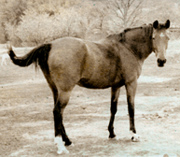The term “backyard horse” does not necessarily spark images of high spending and thousands of jobs. But a closer look reveals that the recreational segment of the horse industry, including the average pleasure rider on their “backyard horse,” generates quite a bit of economic impact and employment opportunities.
 The American Horse Council’s Economic Impact of the Horse Industry on the United States study includes some impressive statistics that confirm the size and impact of the recreational horse industry.
The American Horse Council’s Economic Impact of the Horse Industry on the United States study includes some impressive statistics that confirm the size and impact of the recreational horse industry.
The number of horses used primarily for recreational purposes is by far the largest segment of the horse population by more than one million. According to the Economic Impact Study, there are more than 1.4 million Quarter Horses being used specifically for recreational activities. Another 228,290 Thoroughbreds and 2.3 million horses listed under “other breeds” are involved in equestrian recreation.
The resulting effect on the gross domestic product (GDP) for the recreation industry is $32 billion – $11.9 billion in direct effects and $20 billion indirect and induced effects.
Broken down even further by horse breed, the study shows that Thoroughbreds have a $1.3 billion direct effect and a $3.4 billion total effect (including indirect and induced effects) on the GDP. Quarter Horses have an even larger impact with a $4 billion direct effect and $10.6 billion total effect. The rest of the breeds – classified in the “other” category – have a $6.6 billion direct effect and $18 billion total effect.
While recreational events and activities may not always be as flashy as their racing and competition counterparts, recreation events require thousands of employees to keep all of the money flowing and events running. The Economic Impact Study converts part-time and seasonal employees into a full-time equivalent basis to accurately determine the number of jobs generated by the horse industry. The recreational horse industry generates 128,324 full-time equivalent positions. Jobs associated with recreational Thoroughbreds equal 10,121, Quarter Horses 37,437 and “other” breeds 80,766.
Indirect employment represents jobs provided as a result of spending by industry providers and induced employment represents jobs provided as a result of spending by industry employees. The recreation industry has a total effect on full-time equivalent employment of 435,082 jobs – the largest of any segment of the horse industry.
The American Horse Council’s Economic Impact of the Horse Industry on the United States also analyzes the racing and showing industries and breaks down all of these numbers by state for the 15 states that participated in breakout studies.
The national and each individual state study are available for purchase from the American Horse Council at http://www.horsecouncil.org/
